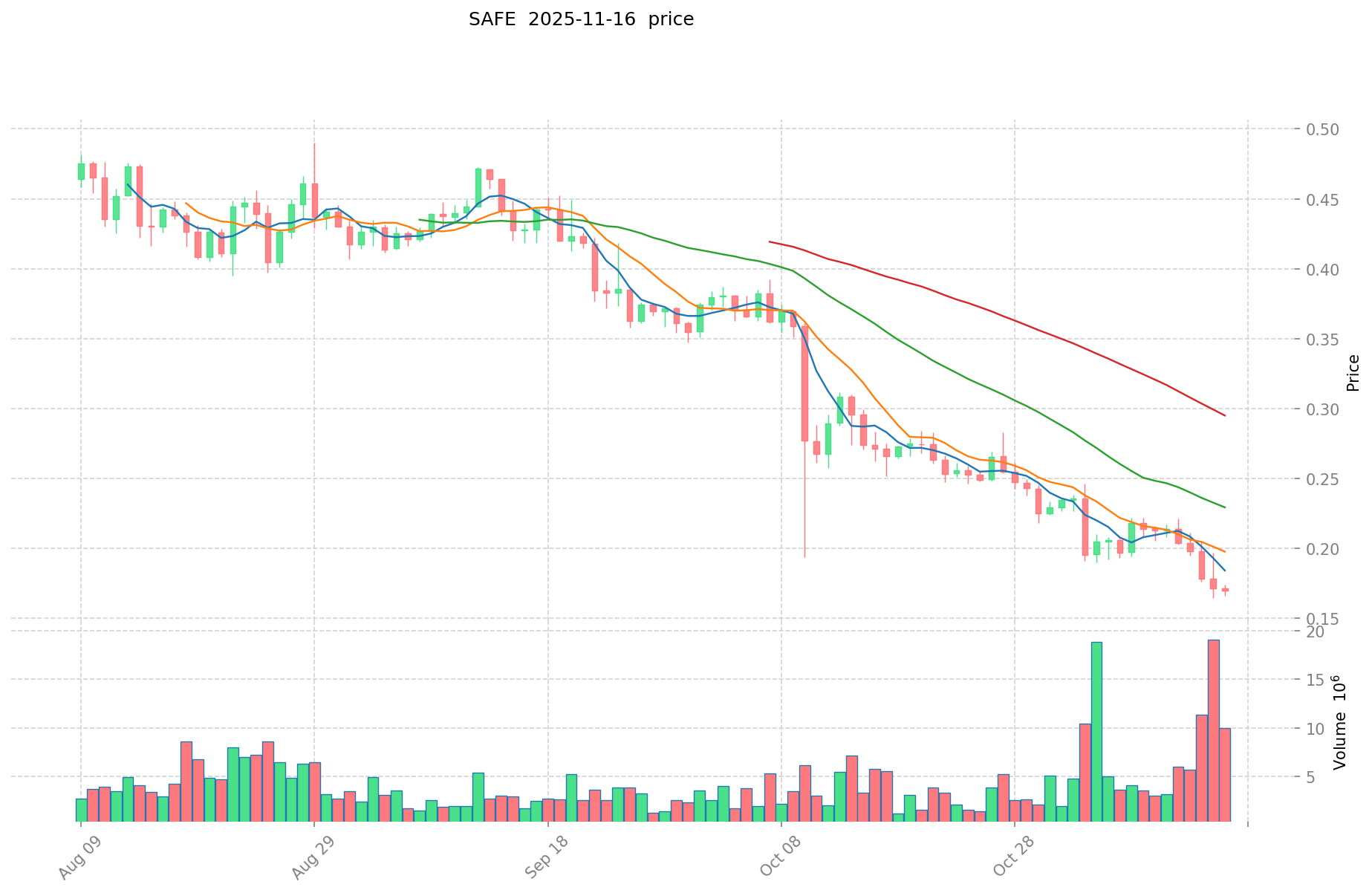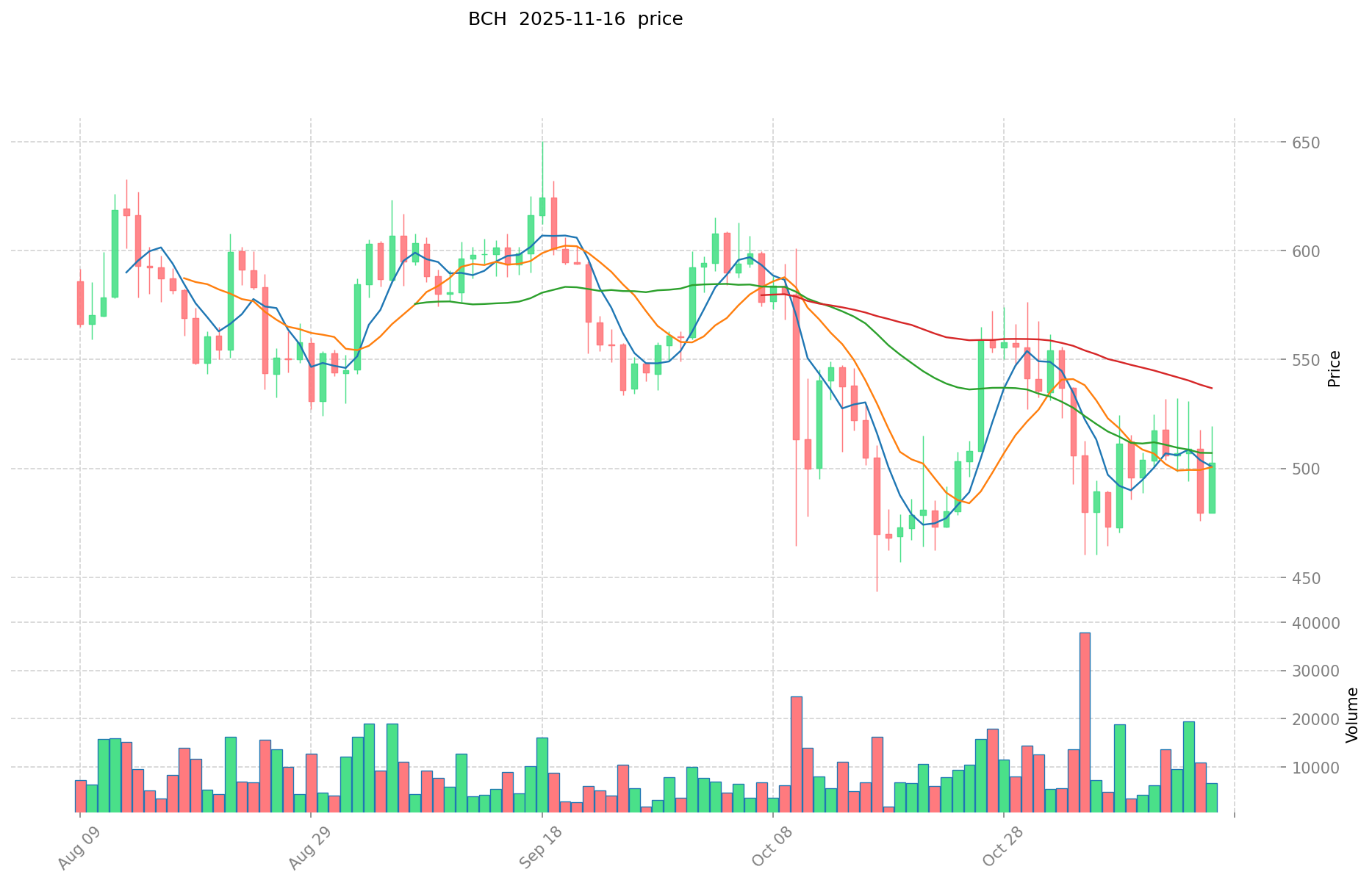SAFE vs BCH: A Comparative Analysis of Two Competing Cryptocurrencies
Introduction: SAFE vs BCH Investment Comparison
In the cryptocurrency market, SAFE vs BCH comparison has always been a topic investors can't ignore. The two not only have significant differences in market cap ranking, application scenarios, and price performance, but also represent different positioning in the crypto asset space.
Safe (SAFE): Launched in 2024, it has gained market recognition as the ownership layer of web3 securing over $100B+.
BitcoinCash (BCH): Since its inception in 2017, it has been hailed as a global payment system, and is one of the cryptocurrencies with the highest global trading volume and market capitalization.
This article will provide a comprehensive analysis of the investment value comparison between SAFE and BCH, focusing on historical price trends, supply mechanisms, institutional adoption, technological ecosystems, and future predictions, attempting to answer the question investors care about most:
"Which is the better buy right now?"
I. Price History Comparison and Current Market Status
SAFE and BCH Historical Price Trends
- 2024: SAFE reached its all-time high of $4.48 on April 23, 2024.
- 2017: BCH was created through a hard fork of Bitcoin, with an initial price of $555.89 on July 23, 2017.
- Comparative analysis: SAFE has experienced a significant decline from its all-time high of $4.48 to its current price of $0.1687, while BCH has shown more stability, currently trading at $499.99 compared to its all-time high of $3,785.82 in December 2017.
Current Market Situation (2025-11-16)
- SAFE current price: $0.1687
- BCH current price: $499.99
- 24-hour trading volume: SAFE $1,663,247.98 vs BCH $1,720,133.88
- Market Sentiment Index (Fear & Greed Index): 10 (Extreme Fear)
Click to view real-time prices:
- View SAFE current price Market Price
- View BCH current price Market Price


II. Core Factors Affecting Investment Value of SAFE vs BCH
Supply Mechanism Comparison (Tokenomics)
- SAFE: Fixed supply model with a maximum cap of 19,890,123 tokens, creating potential scarcity value
- BCH: Fixed supply cap of 21 million coins with halving mechanism approximately every four years
- 📌 Historical pattern: Supply mechanisms with hard caps tend to create cyclical price movements, with assets like BCH historically showing price appreciation around halving events
Institutional Adoption and Market Applications
- Institutional holdings: BCH has gained more institutional recognition with inclusion in some crypto investment products, while SAFE has less established institutional presence
- Enterprise adoption: BCH maintains stronger adoption for payments and cross-border transactions due to its longer history and wider merchant acceptance
- Regulatory attitudes: BCH benefits from regulatory clarity as a Bitcoin fork, while SAFE faces more uncertain regulatory classification
Technical Development and Ecosystem Building
- SAFE technical upgrades: Focus on privacy features and scalability improvements
- BCH technical development: Continued emphasis on on-chain scaling with larger block sizes and transaction throughput
- Ecosystem comparison: BCH has a more established payment infrastructure and merchant adoption, while SAFE is developing specialized use cases around privacy and security
Macroeconomic Factors and Market Cycles
- Performance in inflationary environments: Both positioned as potential inflation hedges due to fixed supply models, with BCH having a longer track record
- Macroeconomic monetary policy: Interest rate hikes typically create pressure on both assets, though market perception of BCH as a "digital gold alternative" may provide some differentiation
- Geopolitical factors: Increased cross-border transaction demand and financial uncertainty tend to benefit both assets, with BCH having wider global acceptance infrastructure
III. 2025-2030 Price Prediction: SAFE vs BCH
Short-term Prediction (2025)
- SAFE: Conservative $0.149787 - $0.1683 | Optimistic $0.1683 - $0.178398
- BCH: Conservative $264.8463 - $499.71 | Optimistic $499.71 - $514.7013
Mid-term Prediction (2027)
- SAFE may enter a growth phase, with prices expected between $0.12481128 - $0.262103688
- BCH may enter a steady growth phase, with prices expected between $460.13696568 - $739.5058377
- Key drivers: Institutional fund inflows, ETF, ecosystem development
Long-term Prediction (2030)
- SAFE: Base scenario $0.3236852095191 - $0.472580405897886 | Optimistic scenario $0.472580405897886+
- BCH: Base scenario $437.776055203402125 - $768.0281670235125 | Optimistic scenario $768.0281670235125 - $814.10985704492325
Disclaimer
SAFE:
| 年份 | 预测最高价 | 预测平均价格 | 预测最低价 | 涨跌幅 |
|---|---|---|---|---|
| 2025 | 0.178398 | 0.1683 | 0.149787 | 0 |
| 2026 | 0.2426886 | 0.173349 | 0.09187497 | 2 |
| 2027 | 0.262103688 | 0.2080188 | 0.12481128 | 23 |
| 2028 | 0.34554002868 | 0.235061244 | 0.11988123444 | 39 |
| 2029 | 0.3570697826982 | 0.29030063634 | 0.1654713627138 | 72 |
| 2030 | 0.472580405897886 | 0.3236852095191 | 0.236290202948943 | 91 |
BCH:
| 年份 | 预测最高价 | 预测平均价格 | 预测最低价 | 涨跌幅 |
|---|---|---|---|---|
| 2025 | 514.7013 | 499.71 | 264.8463 | 0 |
| 2026 | 588.358554 | 507.20565 | 349.9718985 | 1 |
| 2027 | 739.5058377 | 547.782102 | 460.13696568 | 9 |
| 2028 | 740.1905653275 | 643.64396985 | 534.2244949755 | 28 |
| 2029 | 844.139066458275 | 691.91726758875 | 525.85712336745 | 38 |
| 2030 | 814.10985704492325 | 768.0281670235125 | 437.776055203402125 | 53 |
IV. Investment Strategy Comparison: SAFE vs BCH
Long-term vs Short-term Investment Strategies
- SAFE: Suitable for investors focusing on privacy features and ecosystem potential
- BCH: Suitable for investors seeking stability and inflationary hedge properties
Risk Management and Asset Allocation
- Conservative investors: SAFE: 20% vs BCH: 80%
- Aggressive investors: SAFE: 40% vs BCH: 60%
- Hedging tools: Stablecoin allocation, options, cross-currency portfolios
V. Potential Risk Comparison
Market Risk
- SAFE: Higher volatility due to newer market presence and lower liquidity
- BCH: Vulnerability to overall crypto market sentiment and Bitcoin price movements
Technical Risk
- SAFE: Scalability, network stability
- BCH: Mining centralization, potential security vulnerabilities
Regulatory Risk
- Global regulatory policies may impact both differently, with BCH potentially facing less scrutiny due to its longer history and Bitcoin association
VI. Conclusion: Which Is the Better Buy?
📌 Investment Value Summary:
- SAFE advantages: Focus on privacy features, potential for ecosystem growth
- BCH advantages: Established payment infrastructure, wider merchant acceptance
✅ Investment Advice:
- New investors: Consider a smaller allocation to SAFE, larger to BCH for stability
- Experienced investors: Balanced approach, potentially higher SAFE allocation for growth potential
- Institutional investors: Focus on BCH for its established market presence and regulatory clarity
⚠️ Risk Warning: The cryptocurrency market is highly volatile. This article does not constitute investment advice. None
VII. FAQ
Q1: What are the main differences between SAFE and BCH? A: SAFE is a newer cryptocurrency focusing on privacy features and ecosystem potential, while BCH is an established Bitcoin fork with wider merchant acceptance and payment infrastructure.
Q2: Which cryptocurrency has shown more price stability? A: BCH has shown more price stability compared to SAFE. BCH is currently trading at $499.99, while SAFE has experienced a significant decline from its all-time high of $4.48 to its current price of $0.1687.
Q3: How do the supply mechanisms of SAFE and BCH differ? A: SAFE has a fixed supply model with a maximum cap of 19,890,123 tokens, while BCH has a fixed supply cap of 21 million coins with a halving mechanism approximately every four years.
Q4: Which cryptocurrency has better institutional adoption? A: BCH has gained more institutional recognition with inclusion in some crypto investment products, while SAFE has less established institutional presence.
Q5: What are the key technical developments for each cryptocurrency? A: SAFE is focusing on privacy features and scalability improvements, while BCH continues to emphasize on-chain scaling with larger block sizes and increased transaction throughput.
Q6: How do SAFE and BCH compare in terms of long-term price predictions? A: By 2030, SAFE is predicted to reach $0.3236852095191 - $0.472580405897886 in the base scenario, while BCH is expected to reach $437.776055203402125 - $768.0281670235125 in the base scenario.
Q7: What are the recommended investment allocations for conservative and aggressive investors? A: For conservative investors, a 20% SAFE to 80% BCH allocation is suggested. For aggressive investors, a 40% SAFE to 60% BCH allocation is recommended.
Share
Content